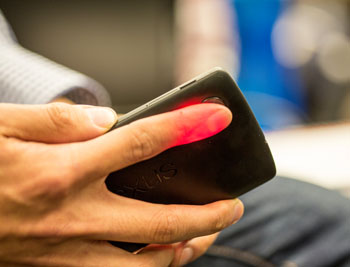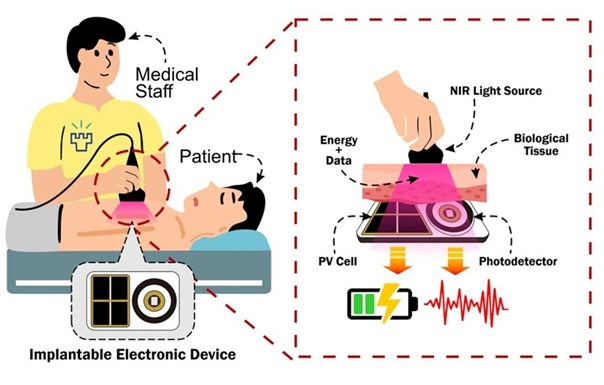Novel App Screens for Anemia without Blood Test
|
By HospiMedica International staff writers Posted on 27 Sep 2016 |

Image: The HemaApp measures hemoglobin levels by illuminating a finger with a smartphone’s camera flash (Photo courtesy of Dennis Wise / UW).
Hemoglobin levels and anemia can be construed non-invasively by illuminating a patient’s finger with a smartphone camera flash, according to a new study.
The HemaApp smartphone application, under development at the University of Washington (UW; Seattle, USA), shines light through a patient’s finger at different wavelengths, as well as infrared (IR) energy, to create a series of videos. By analyzing color absorption and reflectance across the different wavelengths, it detects concentrations of hemoglobin and other blood components, such as plasma. Processing algorithms also use pulse to distinguish between the properties of the patient’s blood and the physical characteristics of the finger.
The researchers tested the app under three different scenarios: using the smartphone camera’s flash alone, in combination with a common incandescent light bulb providing ambient light, and with a low-cost light emitting diode (LED) lighting attachment. The additional illumination sources are used to take advantage of properties found in other wavelengths of the electromagnetic spectrum that present useful absorption properties, but that are not currently found on all smartphone cameras.
In the initial trials, the correlation between HemaApp and the patient’s hemoglobin count on a complete blood count (CBC) test using the smartphone camera alone was 69%, with a common incandescent light bulb the correlation was 74%, and when used with the LED attachment, the correlation was 82%. For comparison, the Masimo (Irvine, CA, USA) Pronto showed a correlation of 81% to the CBC. The study was presented at the International Joint Conference on Pervasive and Ubiquitous Computing (UbiComp), held during September 2016 in Heidelberg (Germany).
“New phones are beginning to have more advanced infrared and multi-color LED capabilities; but what we found is that even if your phone doesn’t have all that, you can put your finger near an external light source like a common light bulb and boost the accuracy rates,” said senior author Professor Shwetak Patel, PhD, of the department of computer science & engineering and electrical engineering. “We’re just starting to scratch the surface here. There’s a lot that we want to tackle in using phones for non-invasively screening disease.”
Related Links:
University of Washington
Masimo
The HemaApp smartphone application, under development at the University of Washington (UW; Seattle, USA), shines light through a patient’s finger at different wavelengths, as well as infrared (IR) energy, to create a series of videos. By analyzing color absorption and reflectance across the different wavelengths, it detects concentrations of hemoglobin and other blood components, such as plasma. Processing algorithms also use pulse to distinguish between the properties of the patient’s blood and the physical characteristics of the finger.
The researchers tested the app under three different scenarios: using the smartphone camera’s flash alone, in combination with a common incandescent light bulb providing ambient light, and with a low-cost light emitting diode (LED) lighting attachment. The additional illumination sources are used to take advantage of properties found in other wavelengths of the electromagnetic spectrum that present useful absorption properties, but that are not currently found on all smartphone cameras.
In the initial trials, the correlation between HemaApp and the patient’s hemoglobin count on a complete blood count (CBC) test using the smartphone camera alone was 69%, with a common incandescent light bulb the correlation was 74%, and when used with the LED attachment, the correlation was 82%. For comparison, the Masimo (Irvine, CA, USA) Pronto showed a correlation of 81% to the CBC. The study was presented at the International Joint Conference on Pervasive and Ubiquitous Computing (UbiComp), held during September 2016 in Heidelberg (Germany).
“New phones are beginning to have more advanced infrared and multi-color LED capabilities; but what we found is that even if your phone doesn’t have all that, you can put your finger near an external light source like a common light bulb and boost the accuracy rates,” said senior author Professor Shwetak Patel, PhD, of the department of computer science & engineering and electrical engineering. “We’re just starting to scratch the surface here. There’s a lot that we want to tackle in using phones for non-invasively screening disease.”
Related Links:
University of Washington
Masimo
Channels
Surgical Techniques
view channel
AI Detects Stomach Cancer Risk from Upper Endoscopic Images
In many parts of the world, doctors must make complex clinical decisions with limited access to specialist support, advanced diagnostics, or pathology services. This is especially challenging in gastrointestinal... Read more
NIR Light Enables Powering and Communicating with Implantable Medical Devices
Implantable medical devices rely on wireless communication and long-lasting power sources to function safely inside the body, yet existing radio-based methods raise concerns around security, interference,... Read morePatient Care
view channel
Revolutionary Automatic IV-Line Flushing Device to Enhance Infusion Care
More than 80% of in-hospital patients receive intravenous (IV) therapy. Every dose of IV medicine delivered in a small volume (<250 mL) infusion bag should be followed by subsequent flushing to ensure... Read more
VR Training Tool Combats Contamination of Portable Medical Equipment
Healthcare-associated infections (HAIs) impact one in every 31 patients, cause nearly 100,000 deaths each year, and cost USD 28.4 billion in direct medical expenses. Notably, up to 75% of these infections... Read more
Portable Biosensor Platform to Reduce Hospital-Acquired Infections
Approximately 4 million patients in the European Union acquire healthcare-associated infections (HAIs) or nosocomial infections each year, with around 37,000 deaths directly resulting from these infections,... Read moreFirst-Of-Its-Kind Portable Germicidal Light Technology Disinfects High-Touch Clinical Surfaces in Seconds
Reducing healthcare-acquired infections (HAIs) remains a pressing issue within global healthcare systems. In the United States alone, 1.7 million patients contract HAIs annually, leading to approximately... Read moreHealth IT
view channel
EMR-Based Tool Predicts Graft Failure After Kidney Transplant
Kidney transplantation offers patients with end-stage kidney disease longer survival and better quality of life than dialysis, yet graft failure remains a major challenge. Although a successful transplant... Read more
Printable Molecule-Selective Nanoparticles Enable Mass Production of Wearable Biosensors
The future of medicine is likely to focus on the personalization of healthcare—understanding exactly what an individual requires and delivering the appropriate combination of nutrients, metabolites, and... Read moreBusiness
view channel
Philips and Masimo Partner to Advance Patient Monitoring Measurement Technologies
Royal Philips (Amsterdam, Netherlands) and Masimo (Irvine, California, USA) have renewed their multi-year strategic collaboration, combining Philips’ expertise in patient monitoring with Masimo’s noninvasive... Read more
B. Braun Acquires Digital Microsurgery Company True Digital Surgery
The high-end microsurgery market in neurosurgery, spine, and ENT is undergoing a significant transformation. Traditional analog microscopes are giving way to digital exoscopes, which provide improved visualization,... Read more
CMEF 2025 to Promote Holistic and High-Quality Development of Medical and Health Industry
The 92nd China International Medical Equipment Fair (CMEF 2025) Autumn Exhibition is scheduled to be held from September 26 to 29 at the China Import and Export Fair Complex (Canton Fair Complex) in Guangzhou.... Read more















